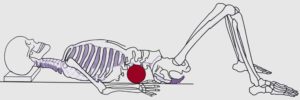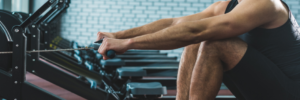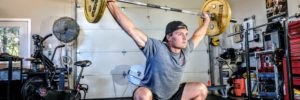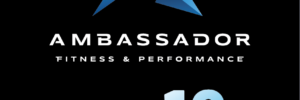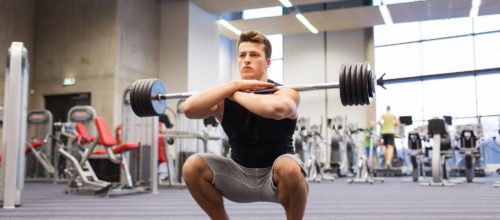
4 Tips for a Better Barbell Front Squat
The barbell front squat is an exercise I like to use as a progression to goblet squats. It’s an exercise you can load up, while not having to worry about grip strength demands. And it tends to be shoulder (external rotation restrictions) and spine friendly.
To perform a barbell front squat, there a few requirements I look for in clients before progressing.
1) Thoracic Extension – Does the client have enough Thoracic extension to get into the proper position without the barbell sliding down their arms? Clients that are kyphotic have a tough time getting into the correct front squat position. For instance, if you get a client with kyphosis to perform a front squat, you’ll often see that the bar rides up against their neck and begins to roll down their arms — running the risk of dropping the bar. It’s not a comfortable position to be in for the client. And it could look like a train wreck waiting to happen.
Clients with a kyphotic posture have to work on improving thoracic extension before considering the barbell front squat. One can improve thoracic extension through mobility exercises such as the Bench T-Spine Mobilization.
2) Grip Set-up – There are three grip positions that I may use with clients. Each has advantages and disadvantages.
Cross-Grip: This is the most common grip set-up I use to coach clients with. It doesn’t require any wrist flexibility, and as long as people don’t have any excessive forward head posture or kyphosis, it makes for a great set-up position. Note: Great for clients with a history of wrist issues (e.g., arthritis, tendonitis).
Clean Grip: Considering I work with a lot of clients that are middle-aged and tend to have an extensive injury history, wrist flexibility isn’t a strong suit. The clean grip may be ideal for a CrossFit athlete or Olympic lifter, but as a result of the increase in wrist flexibility demands, this grip doesn’t mix well with the majority of trainees. However, one tip when it comes to the clean grip is that using 2 fingers compared to 4 fingers reduces the wrist flexibility requirements. The clean grip is an advanced grip progression and isn’t suitable for most.
Straps: The straps are similar to the cross-grip, but they offer a bit more stability and may make people feel comfortable because they’re able to hold the bar up with a firm grip. I may use this grip if a client doesn’t feel comfortable with the cross-grip and feel they need more stability when holding the bar.
3) Tailor Your Brace to the Load You’re Lifting – Bracing involves engaging the core musculature to help stabilize the spine while under load. I tend to tell my clients to think about showing off a 6-pack or engaging your abdominals as if someone is about to punch you in the stomach. If the load you’re lifting is heavy, you’re going to need a strong brace. But if the load is light, you’re not going to need a strong brace. The load you lift should determine your brace.
People with a history of low back pain (e.g., instability of the low back) would have to be aware of their brace during squats. A lack of brace could cause passive restraints (joints, ligaments, bone) to bear more load versus the active restraints (muscles, tendons). And this could perhaps trigger symptoms for someone with degenerative issues (e.g., loss of disc height, osteoarthrosis).
4) Focus on 2-3 Steps on the Walkout – When performing a barbell squat that involves unracking a bar from a rack, you shouldn’t have to take more than 2-3 steps to set yourself. If you’re taking more than 2-3 steps, you’re wasting energy and perhaps have not set yourself with a proper brace to unrack the bar. I’d suggest the next time you unrack the bar that you focus on 2-3 steps versus 5-6 to set yourself.
When it comes to Barbell Front Squatting, it’s a great squat progression for people to work up too. It’s not for everyone, but if you have the adequate upper back mobility and don’t have other squatting limitations (e.g., hip restrictions), it can be a great exercise. I hope the 4 tips above can help improve your front squat and that I was able to shine a light on the benefits of front squatting.
Salute,
Remi
Thumbnail Image Licensed from “Syda Productions/canva.com”


